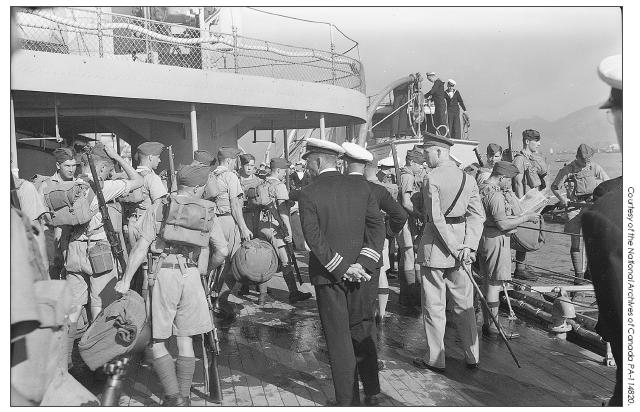Sergeant Gander (6 page)

It was a difficult start to a voyage that was only going to get worse. The
Awatea,
escorted by the HMCS
Prince Robert
, set sail for Hong Kong, carrying a personnel strength of 1,975. Included were: ninety-six officers, 1,877 other ranks, two civilian auxiliary services supervisors, two nursing sisters, two medical officers, two officers of the Canadian Dental Corps and their assistants, three chaplains, and a detachment of the Canadian Postal Corps.
4
The ships were dreadfully overcrowded. Rifleman Sydney Skelton recalls:
We walked around on the deck and nearly everywhere was Out of
Bounds, No Smoking Below Decks, and only smoking in rooms â
officers had the smoking rooms, indeed the officers had everything
⦠Things began to look bad. Supper ⦠came and the lads waited
hours for it and it turned out to be tripe and onions, and it really
was tripe. One thing led to another and the troops were going to
march off the boat ⦠Fifty men got off, and the first time arguing
Gander and the Royal Rifles aboard the HMCS
Prince
Robert
, Novemâber 15, 1941.Gander is front.
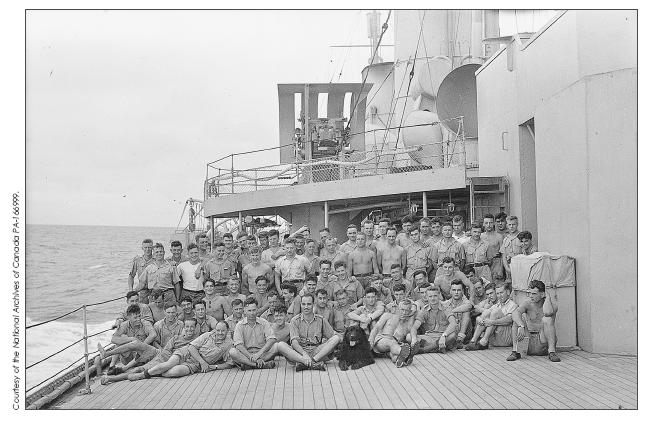
The
Awatea
and the
Prince Robert
The
Awatea
was built in 1936, and was designed to accommodate 540 passengers, a crew
of 342, and weighed in at over 13,000 tons. She travelled at about twenty-three knots,
making her one of the fastest liners in the world at that time. The
Awatea
was a New
Zealand ship and had made most of its early runs between Auckland and Tasmania,
Auckland and Sydney, and from Sydney to Wellington. When the Second World War
broke out, she was fitted with a four-inch gun and was used for the transportation of
troops and refugees, those civilians arriving from the Philippines and Singapore after
the Japanese attacked. She was requisitioned by the British Government in September
1941, to act as a troop transport, and she sailed to Vancouver. Most of the Royal
Rifles and Winnipeg Grenadiers travelled to Hong Kong aboard the
Awatea.
Later
in the war she was used as a troop ship for the Allied landings in North Africa. On
November 8, 1942, the
Awatea
carried troops to Algiers. As she was leaving she was
attacked by Italian bombers and sunk.
The HMCS
Prince Robert
was one of three identical “Prince” ships (
Prince Robert
,
Prince Henry
, and
Prince David
) that the Canadian National Railway
ordered built in the 1920s. The
Prince Robert
was launched in 1930, and could
accommodate 438 passengers and travel at twenty-two knots. She was used mainly as
a cruise ship through the 1930s and when war broke out in 1939 she was requisitioned
by the British Admiralty. The
Prince Robert
performed a wide variety of duties for a
number of different countries during the Second World War.
In early 1941 she was attached to New Zealand, to provide convoy protection
for airmen coming to Canada for pilot training. By the fall of that year she was
requisitioned to act as an escort for the
Awatea
, and assist in transporting the
Winnipeg Grenadiers and the Royal Rifles to Hong Kong. From 1942â43 the
Prince Robert patrolled the Pacific Ocean, intercepting enemy merchant shipping. In 1943, s
he was converted into an auxiliary anti-aircraft cruiser and used to escort
convoys in the Mediterranean and was even used by the Americans for operations
in the Aleutians, a chain of volcanic islands in the northern Pacific Ocean. In July
1945, she joined the British Fleet and returned to Hong Kong in August to assist
in transporting the released Canadian prisoners of war back to Canada. After
her distinguished wartime career, the
Prince Robert
was sold back into mercantile
service. She was subsequently renamed the
Charlton Sovereign
and later the
Luciana
,
and was broken up in 1962.
was all the result they got. The third time the gangplank was raised
and there was nearly a riot. The officers had everything and the
rest nothing, so you could hardly blame them.
5
A view of the eastern end of Hong Kong, as seen from the Prince Robert, November 19, 1941.Gander, however, took it all in stride.
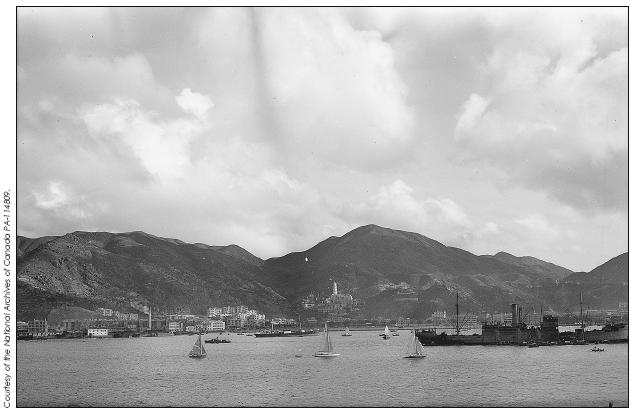
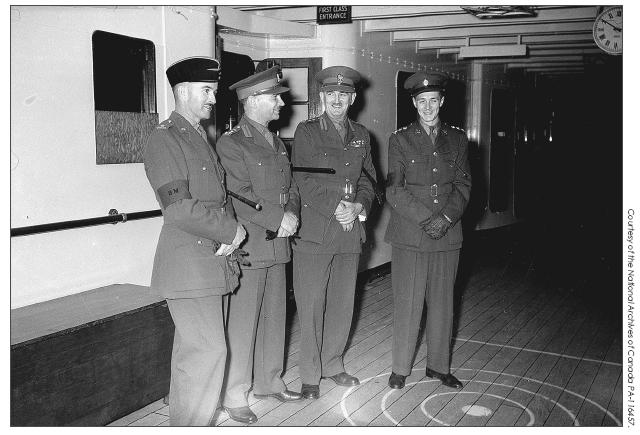
“C” Force's staff officers aboard the
Awatea
(l to r): Major C.A.Lyndon, Brigaâdier J.K. Lawâson, Colonel P.Hennessy, and Captain H.S.A.Bush.
The troops were not idle during their voyage east â training was carried out as often as possible. Rifleman Sydney Skelton recorded in his diary that “we have been drilling every day, Bren guns, two-inch mortars, and anti-tank rifles. They keep us busy with that plus drill, fatigue duty etc.”
6
There were also lectures about the type of enemy that the Canadians could expect to encounter. Rifleman Ken Cambon remembers being told that “the Japanese were all myopic dwarves who wore thick-rimmed glasses and shrank from close combat. They were notoriously poor at night fighting and would not be able to stand up to the bigger white soldiers who had better weapons. Their pilots were sloppy and cowardly. Their obsolete planes, made of wood, would be easy targets.”
7
Such stories reflected the racist nature of the European and Canadian commanders' view of the Japanese, and also served as wartime propoganda to bolster the morale of the soldiers. Similar proganda was practised on both sides.
However, Rifleman Sydney Skelton recalls a different description of what Canadians could expect, from a lecture given to the troops by Major C.A. Lyndon. “He told us to expect almost anything at any time, and he told us if we landed we might have to go right into action. Also he told us we might have the chance of being the first Canadians to go into action in this war. The talk gave us a very grim picture. We were told everything hard about the place and never once did they emphasize anything pleasing. This is no pleasure cruise. It might be another Dunkirk.”
8
After a refuelling stop in Honolulu, where the Canadians had the opportunity to view the doomed American battleships lined up at Pearl Harbor, they continued on to Manila in the Philippines. There, the Canadians picked up an additional escort, the British cruiser the HMS
Danae
. The
Danae
was provided as a result of a message received from the Admiralty that stated, “In view of altered circumstances request you will provide cruiser escort for the
Awatea
from Manila to Hong Kong.”
9
Although the “altered circumstances” weren't made clear, there was clearly some feeling that heightened security was required to ensure the Canadian contingent reached their destination. After three weeks at sea, “C” Force arrived in Hong Kong.
The colony of Hong Kong consisted of a group of islands (the most important of which is called Hong Kong) located just south of the Chinese mainland, the Kowloon Peninsula (ceded by China to the British in 1860), and the New Territories (leased by the British from China in 1898, for niniety-nine years) on the adjoining mainland. Altogether the colony covered an area of about 1,095 square kilometres.
1
The Island of Hong Kong, ceded to the British in 1841, covers an area of about eighty square kilometres, its landscape dominated by mountains with very little flat land to be found. Lying just south of the Tropic of Cancer, Hong Kong has a subtropical climate with hot, humid summers and cooler winters. Strategically located between the Taiwan Strait, the South China Sea, and the Pacific Ocean, it provided an excellent channel for sea traffic between Asia and the rest of the world. Moreover, the deep waters surrounding Hong Kong and its wide, mountain protected harbours combined to make its ports, especially Victoria Harbour, extremely desirable.
Under British rule since the mid-1800s, the colony had a largely Chinese population under the control of a British governor. The population in 1941 was approximately 1,729,000, with about 800,000 of that number living on Hong Kong Island. The Royal Navy had used Hong Kong as its major outpost in Asia up until the end of the First World War, but its position was considered vulnerable. A 1921 War Office Study reported that “there was no chance of making Hong Kong sufficiently secure against attack.”
2
It was simply too remote from the nearest sources of any British reinforcements, and its harbours, while ideal for commercial trade, were not large enough to house a fleet of modern ships.
3
Therefore, Britain turned to Singapore and constructed an impressive naval base there, which eventually replaced Hong Kong in terms of naval importance. However, the British still maintained a presence in Hong Kong, and despite the gloomy predictions of
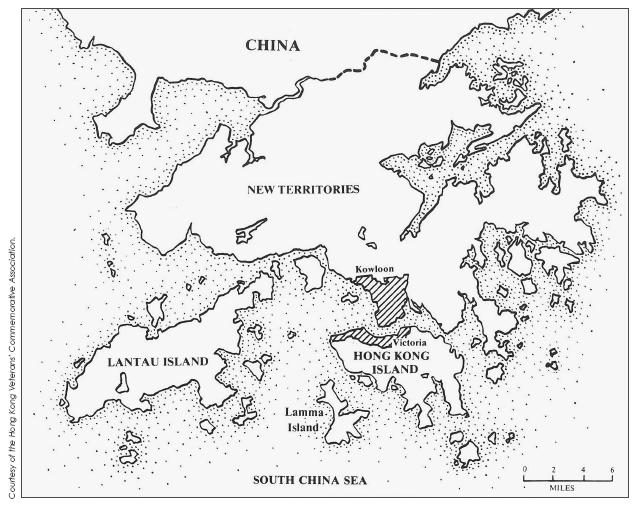
The Crown Colony of Hong Kong, 1941.
the 1921 report, the 1936 Hong Kong defence scheme stated, “Hong Kong is ⦠a strategic point vital to the conduct of our Fleet, Army and Air Force.”
4
The Canadians arrived in Hong Kong on November 16, 1941. The soldiers disembarked and began marching towards Sham Shui Po Barracks, with Gander leading the way. Rifleman Bruce Cadoret remembers the scene, recalling, “We
